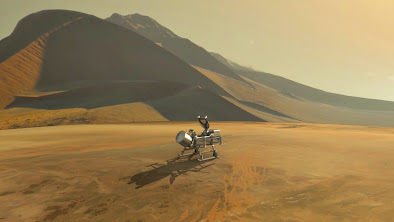Creating a little piece of Mars......... and beyond. Scientists use a variety of techniques to simulate the conditions of faraway planets in their laboratories.
TITAN - A MOON OF SATURN, is the only world in the solar system other than Earth with standing bodies of liquid on its surface.
In the imagination, astronomers look through telescopes, and photonic wisdom pours in at the speed of light. Taking what they can get, they passively receive information about far-off stars and planets. These objects are fixed, and their conditions cannot be tweaked.
But that's not how all astronomy works. Planetary and exoplanetary scientists, for instance, don't just wait for data to come to them : They also construct miniature versions of other places using convenient geological landscapes, gravel crushers and simulation chambers on Earth.
THE DUST OF ANOTHER WORLD
The most direct link between the world and those beyond is the '' terrestrial analogue, '' a physical location on Earth that resembles some aspect of another world - usually the moon or Mars.
That relevance can take the form of geological formations, like lava tubes or sand dunes, or it can be a whole region with lunar or Martian flair, like the Atacama Desert in Chile or volcanoes in Hawaii.
Dr. Lee runs the Haughton Mars Project, an analog research facility on Devon Island, an uninhabited, barren Arctic outpost in Nunavut, Canada. ''There's an incredibly wide array of features that are similar to what we see on the moon and on Mars,'' he said.
The island is permacold and dry, with valleys and canyons, and there is a 14-mile wide crater left from a cosmic impact. That's about the same size as Shackleton Crater at the lunar South Pole, where NASA plans to send astronauts this decade.
During dozens of field campaigns, the Haughton research station has provided scientists with conditions comparable to those on the moon or on Mars, allowing them to study similar geology, test equipment for future missions to train humans to take part.
''It's a bit of a turnkey operation,'' Dr. Lee said. A core habitat facility spokes into a series of tents for geology, astrobiology, medicine and administrative and repair work. A greenhouse stands alone, while ATVs and Humvees support travel and simulate rovers.
Dr. Lee spend 23 straight summers at the facility, eating canned sardines in the cold on day trips away from the main camp. But in 2020 and 2021, the pandemic forced him to skip his annual journeys to that other world on Earth. He missed the simplicity and the isolation.
''When you are there, you are the population of Devon Island,'' Dr. Lee said.
There are times, though, when scientists don't need to go to an analogue : They can bring it home in the form of simulants, or material that resembles the surface of the moon or Mars.
Mars, for instance, is covered in sand and dust that scientists call regolith. It makes travel difficult and can also block solar panels, clog filters and cause moving parts to seize up. To determine how robotic rovers, power sources and other hardware will withstand those rigors of the red planet, scientists must test them against something similar before they make the journey.
In these simulacra, they see, feel and control worlds - ot at least metaphors for them - in an attempt to decipher parts of the universe they'll likely never visit.
In making the untouchable physical and the abstract concrete, they create not just similes but ways to conceive of these planets and actual places.
'' Throughout science, we reason by comparison all the time,'' said Pascal Lee, a planetary scientist at the Mars and SETI institutes. '' And so there's something very fundamental to the approach of using analogues.''
Their methods are in keeping with scientific traditions that values both laboratory-based research and direct contact with nature.
''It actually makes a lot of sense why planetary scientists, whose phenomena are removed in time and space, would think that simulation and replication would be how they could still study that which is remote,'' said Lisa Messeri, an anthropologist at Yale University and the author of the book ''Placing Outer Space,'' because that's what science has been doing for hundreds of years.''
The Publishing continues in the near future. The World Students Society thanks author Sarah Scoles.

.png)


0 comments:
Post a Comment
Grace A Comment!